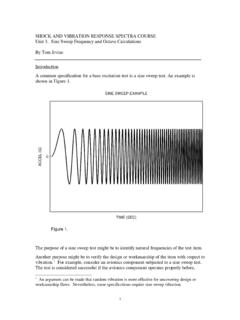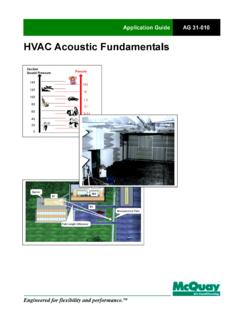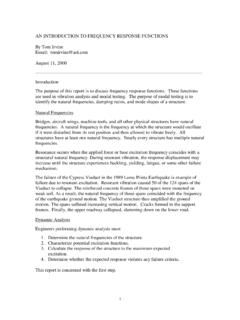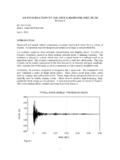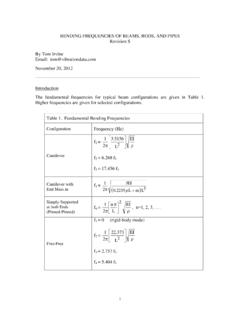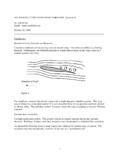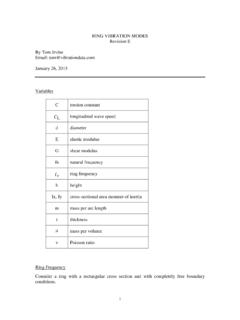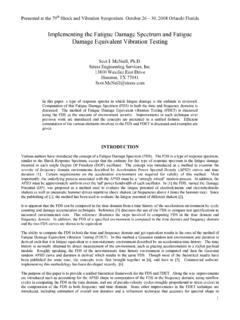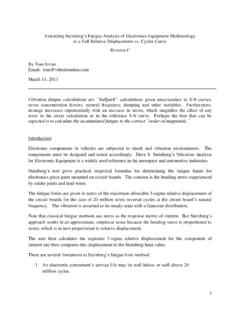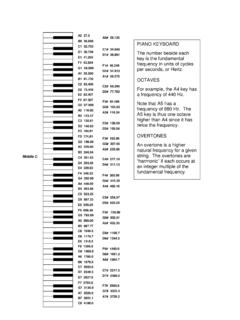Transcription of Half Sine Shock Tests to Assure Machinery Survival in ...
1 Half sine Shock Tests to Assure Machinery Survival in Explosive Environments By Howard A. Gaberson, , Chairman MFPT Diagnostics and Signal Analysis Committee 234 Corsicana Drive Oxnard, CA 93036 ABSTRACT Previous work has shown that traditional four coordinate pseudo velocity Shock spectrum is the best format for violent machine transient foundation motion analysis. It emphasizes the motion severity. This paper applies these results to the theoretical half sine and other simple test pulses. It shows the simple pulses strongly related to actual explosive transients. The trick turned out to be inclusion of pre and post pulse motion in the calculation. The calculations applied to shaker Shock pulse motions are also discussed. INTRODUCTION Previous work has shown that traditional four coordinate pseudo velocity Shock spectrum is the best format for violent transient foundation motion analysis if one is trying to indicate severity [1, 2, 3].
2 It emphasizes the motion severity. This paper applies these results to the theoretical half sine and other simple test pulses, and in so doing, establishes three unappreciated characteristics of the simple Shock pulses. Inclusion of the drop and any rebound in the pseudo velocity Shock spectrum plotted on four coordinate paper (PVSS on 4CP) shows the simple pulses similar, as observed by Gertel and Holland [4]. Shock spectra for explosive environments are shown similar to those of simple pulse Tests produced on a drop table except for directionality. The trick turned out to be inclusion of pre and post pulse motion in the Shock spectrum calculation. Shock spectrum calculations applied to shaker generated Shock pulse motions show that simple pulse Tests conducted on a shaker with limited displacement do not match the low frequency severity of drop table shocks.
3 A difficulty with this paper is as follows. You can t confirm what I have done unless you have a Shock spectrum program and the ability to plot the results on four coordinate paper. In that sense this is a "trust me" paper. Good Shock spectrum programs are not common. I will give you my MATLAB program, [5, 6], and Assure you that I have been using it for 20 years or more; I see no bugs in it. Only recently have I programmed good 4CP, but that correctness is easily verified. PSEUDO VELOCITY AND FOUR COORDINATE PAPER. The Shock spectrum is a plot of an analysis of a Shock motion ( , transient motions due to explosions, earthquakes, package drops, railroad car bumping, vehicle collisions, etc.) that calculates the maximum response of many different frequency damped single degree of freedom systems (SDOF) exposed to the motion.
4 The plot is a graph of maximum response versus frequency. Pseudo velocity is specifically the maximum relative displacement times frequency in radians. It is surprising and not trivial, but this is the important quantity to plot for Shock spectra when you want to indicate severity or capacity to cause damage. The best way to plot these is on four coordinate paper (4CP) (also called tripartite paper). Four coordinate paper is a logarithmic graph paper that has four sets of lines relating frequency, displacement, velocity, and acceleration of sinusoidal motions. The Shock spectrum algorithm finds the peak relative displacement for a base excited SDOF. That's the maximum energy stored in the elastic member during the transient event. At that instant of time the velocity was zero, thus there was no damping force, so the force in the spring at that instant times the mass was the acceleration at that instant too.
5 If that maximum elastic energy stored in the spring during the Shock were converted to velocity (kinetic energy) in the next or previous quarter cycle, that velocity would be (equating the kinetic and elastic energies): 2222zmkvor,2mv2kz== (1) Since k/m = 2, we find: zv = (1a) That v is the pseudo velocity. We calculate zmax for each frequency, and we plot zmax on four coordinate paper. The reasons why PV is so good are a little cloudy and difficult. The typical engineering structures explanation is given in Reference [7]. It needs more thought, but I'll give you my best now.
6 Peak modal velocity in elastic structure is proportional to peak stress, and not acceleration as most still do not know [2, 8, 9, 10, 11, 12]. Say we have a steel chair, mounted on a shaker set to shake it horizontally and find its first mode. The top of the back of the chair will have the highest modal velocity (measure the peak acceleration and divide it by the frequency in radians). The peak stress is probably where one of the chair legs is welded to the seat. That peak stress in psi will be a constant between 1 and 5 times 146 times that velocity in ips. That is a fact [2, 9], and it is also true for second and third and all of the modes if we know for each, the peak velocity location and the peak stress location. Pseudo velocity is the best quantity to predict the potential to generate modal velocities in structure.
7 Relative velocity does not indicate modal velocity at low or high frequencies; it matches PV only in center severe section of the Shock spectrum. The asymptotic behavior of the PVSS is summarized as follows [2, 3]. When the PVSS is plotted on 4CP, the displacement is exact. One can expect to see two asymptotic values: at the high frequency end of the Shock spectrum the curve should approach the peak pulse acceleration, and at the low frequency end of the spectrum it should approach the peak Shock deflection. For intermediate values of the frequency, the peak pseudo velocity is often almost constant. Four coordinate paper (4CP) (tripartite paper) is important to the PVSS presentation. For a sinusoidal motion, the displacement, velocity, and acceleration are: tsinzz,tcoszz,tsinzzmax2maxmax = = =&&& (2a) By equating the maximum values we have: maxmaxmaxmax2maxmaxzz,zz,zz&&&&&& == = (2b) The four quantities: ,2,,,maxmaxmaxforandzzz &&& are related by Eq.
8 2b. Knowing any two, you can calculate the other two. By taking logs the lines of constant ,z,z,zmaxmaxmax&&& versus ,f2or, are all straight lines. That is why we can compute the plot of Figure 1. THE SIMPLE PULSES HAVE SIMILAR Shock SPECTRA WHEN PLOTTED AS PVSS ON 4CP To make the point of simple pulse similarity, I have to calculate the PVSS on 4CP for all the simple shocks and there is not space to present individual plots for each Shock . The obvious way to show them similar is to superpose all of their spectra on a single composite plot and that is done in Figures 2 and 3. Below I will describe the characteristics of each Shock and the compromises I had to make to prove this point. a. Half sine Shock Half sine shocks are usually specified by a peak acceleration and a duration, such as an 11 millisecond 30g half sine .
9 The Shock has peak acceleration, mx&&, and duration td ; there is a frequency associated with this duration since it is half of one period of a sine wave with frequency, fd = 1/2td . dddmaxt21fwhere,tf2sinxx= =&&&& (1) The velocity change during the half sine pulse is very important. Assume zero initial velocity and integrate over the half cycle to get the final velocity, which is the velocity change. = = dmaxdmaxtx2fxx&&&&& (2) This result is important. It relates three important pulse properties: velocity change, peak acceleration, and duration. Two of these, ,x,xmax&&& are apparent on the pseudo velocity Shock spectrum.
10 The Shock spectrum of this pulse by itself is what is usually computed. A package is sitting on the table and somebody belts the table upward with a rubber mallet in a zero g situation, and the package continues going off into space at constant velocity. It is unrealistic, and leaves the low frequency asymptote (content or limit) out. Yet we find this in every book on Shock that presents the half sine Shock spectrum. I am going to plot many Shock spectra in this paper and I am going to select fairly severe parameters so you can get familiar with severe Shock spectra. I will use a velocity change of 100 ips and peak g level of 200gs. Let's plot the above Shock along with its two integrals, and then calculate the Shock spectrum for this nude half sine Shock . Using Eq. (2) we find the duration to be ms.
